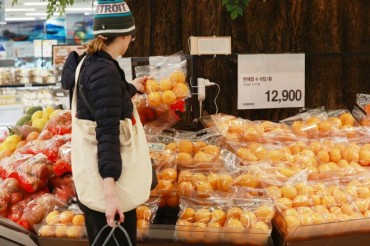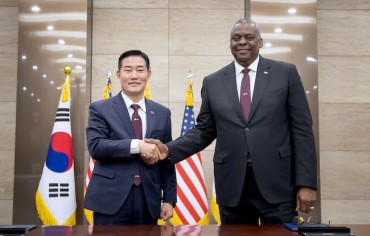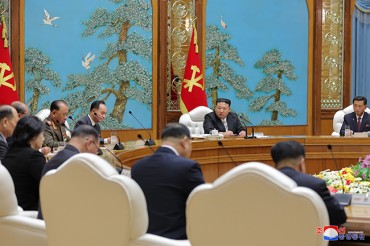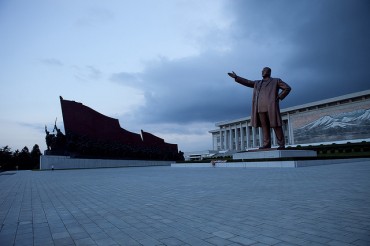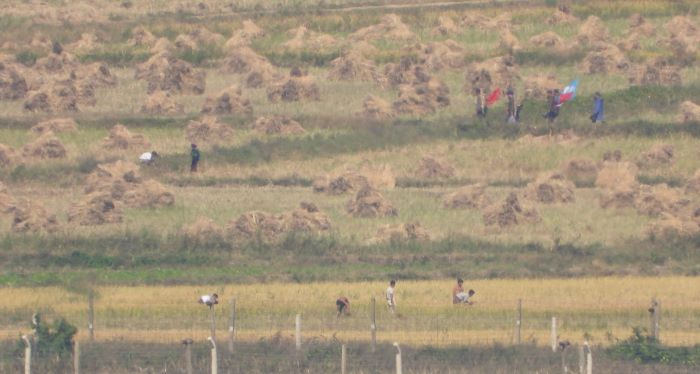
Straw bales are stacked in a harvested rice field in Kaepung County, North Hwanghae Province, North Korea, as seen from the Ganghwa Peace Observatory in Ganghwa County, Incheon, on the morning of Oct. 6. In its recently released “North Korea Seasonal Crop Outlook for the 2023-2024 Agricultural Year,” the U.S. Department of Agriculture estimated North Korea’s rice production this year at 2.1 million tons, a similar level to last year (Image courtesy of Yonhap)
SEOUL, Oct. 10 (Korea Bizwire) – North Korea may stage various provocations, including a nuclear test, to divert its public’s attention from the country’s ongoing food crisis, South Korea’s defense ministry said Tuesday.
The ministry made the assessment in a policy report for a parliamentary audit amid growing tensions after North Korea revised its constitution late last month to stipulate the policy of strengthening its nuclear force.
“In order to pass on internal complaints of food woes and failures in economic policy to the outside world, there is a possibility of (the North) conducting various strategic and tactical provocations, including a seventh nuclear test,” the ministry said in the report.
The isolated regime, which has faced chronic food shortages, last conducted a nuclear test in September 2017.
The ministry also assessed that the North is expected to make efforts to successfully launch a military spy satellite this month as planned.
North Korea announced plans for the launch after its attempts to put the satellite, named the Malligyong-1, in orbit in May and August ended in failures.
The ministry also said the North Korean military appears to be focusing on supporting farming efforts during the harvest period, noting that it has not staged a large-scale exercise near the border after its summertime drills.
In addition, the ministry vowed to bolster the country’s defense capabilities against North Korean threats, with plans to complete exploratory development of the low-altitude missile defense system, designed to intercept North Korean artillery shells, by August next year.
The ministry outlined efforts to strengthen combined military drills with the United States, such as staging their regular springtime Freedom Shield exercise in March next year for 11 straight days.
The allies also plan to develop the regular Ulchi Freedom Shield exercise in the second half of the year so that it proceeds under a scenario of a North Korean nuclear attack, it added.
During the parliamentary audit, the Joint Chiefs of Staff (JCS) said the South Korean military is preparing for potential surprise attacks by North Korea, drawing lessons from Palestinian military group Hamas’ assault on Israel.
Kang Shin-chul, the head of the JCS operation headquarters, said Hamas blindsided Israel Saturday by firing over 5,000 rockets in a short span of time to breach Israel’s Iron Dome air defense system.
He outlined similar tactics Pyongyang could use, including surprise attacks, diversifying attack means, exploiting vulnerabilities in advanced defense systems and psychological warfare using domestic social medial platforms.
In the event of the North’s artillery shelling, infiltration by special commandos and drone attacks, South Korean troops are ready to intercept missiles at an early stage and shoot down drones through joint operations, according to the three-star Army general.
“Through the execution of large-scale firefights, (the South Korean military) will remove the enemy’s long-range artillery that threatens the Seoul metropolitan area, while interceptors will provide protection for major facilities and key units in the area,” Kang said.
(Yonhap)



